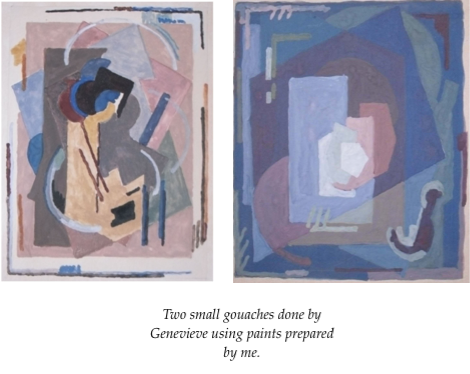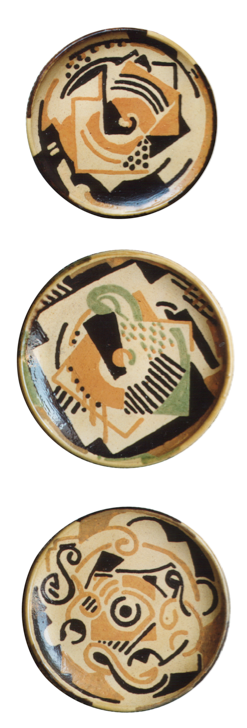My own difficulties were compounded by a problem Genevieve had encountered when teaching the young people who had come looking for an alternative lifestyle. The very first exercises, confined to the horizontal and vertical, are also exercises in colour, confined to the different shades of a single colour moving from dark to light or from light to dark. Genevieve had found, however, that as her students added more and more white, the base colour, instead of becoming more luminous, was becoming more plastery or dull. It was not a problem that she had experienced herself when working with Anne Dangar in the 1940s and at first she thought it was a strange lack of skill on the part of her students. But she was soon persuaded that there was a problem in the nature of commercially available paint.
Genevieve was not herself a painter and the problem was not acknowledged by the painters in the Association, so she launched me into what became quite a long research into the characteristics of different pigments. With regard to the white the desired luminosity could be obtained by using chalk. But this could not be used with oils and when mixed with water it disappears, making it difficult to judge the quantities that would be necessary (though the process of watching the colour appear as it dried was rather wonderful). With regard to oils the solution was lead white, increasingly difficult and now almost impossible to obtain. But the problem went beyond white and it was not until I managed to obtain a batch of madder red (not to be confused with rose madder) that I had a range of colours she herself was willing to use.

The period of my stay in Ampuis coincided with two very hard blows that struck Genevieve in rapid succession. The first was the loss of her right arm. As a consequence of an earlier successful treatment for breast cancer, it swelled up suddenly, almost overnight, becoming unusable, except as a dead weight. Soon afterwards, she was hit again by the death of her ever helpful, ever cheerful and, one might add, ever tolerant husband, Charles. Her adaptation to these changes was astonishing. She could no longer turn as a potter but happily she had a friend, Jean-Jacques Bernard, who had taken on Paquaud's old pottery in Roussillon and was able to turn the larger pieces for her (her daughter Aguilberte could do the smaller pieces. I was assigned the comparatively easy job of making smooth rectangles of clay that could be decorated and fired as tiles). She was soon able to decorate with her left hand and her last firings were among her finest, including a series of plates illustrating the three stages - translation, rotation, rhythm - that she had hoped to teach in Moly. She had said that the difference between her own work and that of Anne Dangar was that Anne was much freer as an artist. Genevieve saw her own work as 'scolaire', studied, conceived as a material for teaching. That was her view, it isn't necessarily mine. Certainly the principle of translation/rotation is, as one would expect from knowing her, very visible in her work but far from suffering a lack of freedom it reveals the strength and the complexity of the method. Genevieve's pottery, as much as Gleizes's painting, is a 'support for contemplation'.

Three plates by Genevieve Dalban, glazed earth, diam c 23 cms, c1999. Although all three stages can be seen in each of the plates the emphasis in the first is on the stability (translation), the second on the inclination of the planes rotation) and the third on the linear arabesque (rhythm)
The period in which I lived and worked in Ampuis was both sad and privileged. Sad because during that time many of the last generation who had known Gleizes died - Genevieve herself, André Dubois, Henri Viaud, Jean Chevalier, Walter Firpo, Paul Regny (his wife Andrée Lecoutre, herself a painter, had died just before my arrival), Daniel Gloria, René Dürrbach, Jacqueline Dürrbach. Privileged because I had a chance to meet and talk with them. I shared in the quarrels that divided them and in the love that had brought them together. In particular I share Genevieve's view that, however improbable it might seem at the present time when there appears to be no succession, this is an art that is solidly based and has a future. It is a means that can be used by painters in the future, even if this turns out to be a very slow development. Gleizes in some ways developed too fast. The transition from translation to the arabesque resembles the transition in Islamic calligraphy from Kufic to Nasta'liq, a transition that took several centuries. I remember Firpo saying Gleizes had told him that there were still many unrealised possibilities in the early 'multiple perspective' phase of Cubism, that the painters had envisaged the 'end' of Cubism (the flat surface) and been in too much of a hurry to reach it. We, perhaps, need to proceed more slowly. More slowly even, perhaps, than the year of translation, the year of rotation and the year of rhythm envisaged by Genevieve Dalban for the proposed course at Moly Sabata.